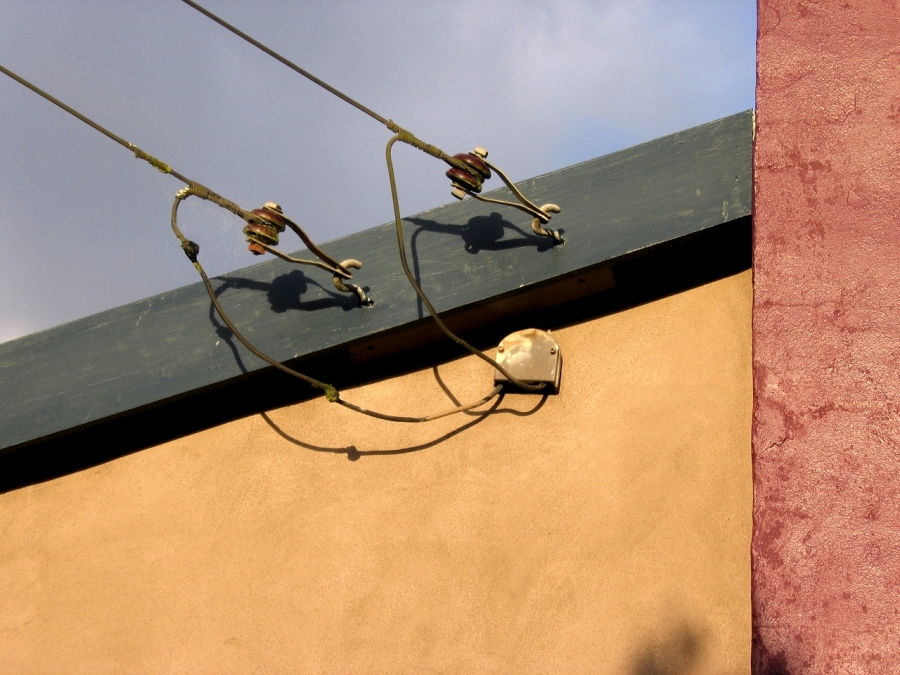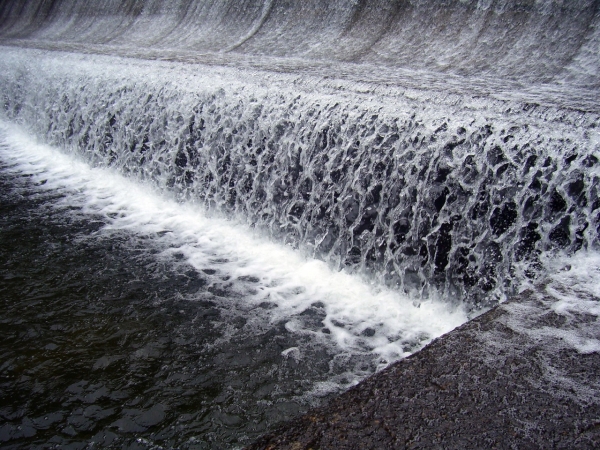Watts It Matter to You? Electricity Distribution
As stated in Watts it Matter to You? Electricity Transmission, the American Society of Civil Engineers (ASCE) assigned the United States’ ENERGY infrastructure a grade of “D+” on their 2009 Report Card for America’s Infrastructure. “Electricity Distribution” explains the final step in the path of electricity from a power-generating facility to your home or business. It covers the electric utility business model, how the distribution infrastructure drives generation and transmission decisions, and metering electricity.

U.S. Infrastructure Series
U.S. Infrastructure - Obvious But Unnoticed
Three Square Miles Of Concrete
A Bridge To Everywhere
It's About Dam Time!
We Might Have A Drinking Problem
Electricity has different aspects than the other infrastructure categories we’ve discussed in our featured series, such as drinking water. “There’s currently no cost-effective storage for power,” Bill Randle, a consultant to the electric utility industry emphasizes, “so the real challenge is focused on building infrastructure that is a good match for our pattern of usage. Electricity is demanded by consumers every time they throw a switch or change their thermostat setting. The electrical infrastructure is such that it responds instantly by increasing the generation and corresponding flow on the transmission and distribution system. Electric utilities don’t have an option to say ‘We are currently sold out, please try again later.’ ”
Electric Utility Business Model
Electric utilities are perhaps the last monopoly in our business world. They have very specific service territories and are responsible for building and maintaining the distribution grid required to provide electrical service to all end customers within that service area, without prejudice, as part of their charters. Each electric utility distribution system throughout the country is composed of varied configurations of substations, step-down transformers, switchgear, relays, voltage regulators, and distribution lines, ending with the meters that record the electric power consumed by individual homes or businesses. The established service boundaries for each electric utility are not often changed, except via corporate merger or acquisition.
Most electric power (70%) delivered in the U.S. is provided by investor-owned utilities (IOUs). The majority of our remaining electric power is delivered by non-profit entities (i.e. rural cooperatives and municipalities). Non-profit providers are motivated by a need to achieve financial reserves for future capital projects, without the additional requirement of creating steady dividends for shareholders. The rate structure charged by the IOUs for each kilowatt-hour (kWh) of energy consumed or kilowatt of peak demand power is determined by local Public Utility Commissions (PUCs). These commissions are typically made up of political appointees.
Distribution Infrastructure Drives Generation and Transmission Infrastructure Decisions
The IOUs must appeal to their local PUC with a “rate case” to determine the rates charged. So utilities must be attentive to accommodating the commissions’ views on what is best for their voting constituents. For decades, the plan for capital investment in electrical infrastructure was largely driven by weather, population, and economy forecasts. Now there is an emphasis on leveraging new technology to create programs and incentives at the distribution level so as to encourage customers to reduce their energy use or move it from “on peak” to “off peak” hours so as to avoid or delay having to build new power plants and transmission lines.
Increasingly, electric rate makers are recognizing that the cost of making and delivering the next kilowatt demanded by the consumer varies with the total instantaneous demand, and that demand can vary significantly over the course of each day. A theoretical example makes the challenge clear. If everyone used all of their daily electricity between noon and 1PM, we would require 24 times the generating and transmission infrastructure than if electrical use was perfectly level throughout the day. In practice, utilization varies significantly with weather and daily activity.
The rates charged for electricity can also vary quite significantly between adjacent IOUs, even though they sell exactly the same product, may be governed by the same PUC, and are tied into the same national transmission grid. These price differences are largely driven by the individual utility’s ability to control costs, use capital effectively to build optimal infrastructure, and obtain favorable rulings from their PUC.
At a national level, environmental concerns and a desire to conserve energy and reduce fuel use play heavily in how electrical infrastructure will be deployed in the coming years. New power plants and new transmission lines take many years to build and require a very large capital commitment. Rather than simply building generating facilities in locations that can readily meet whatever the demand might grow to be if left unchecked, there is a concerted effort to find ways to reduce overall energy use (via efficiency programs), level the demand for power across all times and seasons (via time-of-day rate structures and demand charges), and minimize the use of fossil and nuclear fuels (via pollution control technology investments at existing plants and the addition of renewable generating technologies with new transmission lines).
In the first two parts of this series, we addressed electrical generation and transmission infrastructure. The stakeholders (utilities, PUCs, EPA, rate payers) anticipate that it will be new infrastructure and rates deployed at the distribution level that motivate the consumer to conserve energy and level power use so as mitigate the need for energy infrastructure at the generation and transmission levels.
So what new technologies are PUCs supporting for large-scale integration into the distribution infrastructure?
Smart Meters, Smart Thermostats, and Data Communication
Traditionally, the electric meters of residential customers have just measured energy use and the meters of industrial and commercial customers measured energy use plus peak power demand for the month. The utility would send meter readers out once a month to collect one or two readings from the meter, and those were the parameters used to produce the bill. Any automation of this process has typically aimed to speed accurate readings by using low-power radios to capture the same data while the meter reader walked or drove by. Also, utilities traditionally have relied upon phone calls from customers to learn of power outages.
A key component of any future “smart” grid system will be a “smart” communicating meter -- one that can work in conjunction with new programmable “smart” thermostats to make consumer power use decisions based on new time-of-day rate structures , considering the needs of the home or facility that it’s wired into. Understanding the business realities and nature of electricity, Randle feels that the goal of any smart metering will be to even out the 24-hour electric load, to the practical extent possible. By sending each consumer (via their smart meter) a pricing signal, electric consumption patterns might be beneficially altered such that comfort levels are balanced against pocketbook impact.
The smart meters are designed to capture much more information than simple energy use or peak demand. Voltage levels, outage durations, power quality indicators, power theft detection, and power use profiles all would be accessible remotely over new two-way data communication connections to the meters. The meters are designed to receive price signals from the utility and pass them on to the customers’ thermostats via an additional data communication link. Another new aspect of smart meters is their ability to allow remote disconnect and reconnect via new bases, so as to save the cost of utility service calls.
We have a national desire to reduce our dependence upon foreign oil, and that desire is resulting in significant R&D expenditures on plug-in hybrid electric vehicles (PHEVs). If PHEVs become practical, they will place a new demand on the electrical grid and present some challenges in getting the right charging outlets and metering in place.
Besides the obvious new infrastructure, the back office changes required to allow the utility to collect and intelligently process hundreds of times more information per customer and to produce accurate bills under new, complex rate structures will require a significant investment. Much work is being put into establishing standards for exchange of information and interoperability of new equipment, but the task is daunting.
Will Customers Benefit?
Many savvy commercial and industrial consumers already do “load-leveling” or “peak-shaving” in some form or fashion. For example, at larger facilities which run a chilled-water plant for building cooling, an ice-storage unit as discussed in Buildipedia.com’s Division 23 Knowledge Base might be installed. Larger businesses are impacted to a greater extent by variable electricity rates, based on volume of power consumed alone. Therefore, they tend to be more involved in these issues than the average homeowner and may have already invested in some tools to help them reduce electricity costs. Many large businesses and industries will often justifiably dedicate staff, software, equipment and production routines to take advantage of lower electricity prices during particular times of the day.
Domestic Smart Meters
However, smart meters that manage the domestic power consumption of homeowners are not necessarily impractical. Consider a 4,000 square foot home that has a heated swimming pool, perhaps a few freezers and several hot-water heaters. A smart thermostat could operate these devices throughout the night when the residents are sleeping with the result of significantly reducing costs; however, the cost of smart meters coupled with smart thermostats may not make financial sense for customers with small electric loads.
Randle was first involved in this issue nearly 20 years ago, in the early 1990’s, when smart metering was in its infancy, working with more cumbersome (although effective) smart metering equipment. He was involved in the installation of pilot program metering equipment in hundreds of homes at that time. The pilot program demonstrated that smart metering is technically feasible and may make financial sense for homes with large electric loads to control, but broad deployment will require a significant degree of homeowner involvement to make it worthwhile, and it is questionable whether that will happen, given our culture.
The recent American Recovery and Reinvestment Act (ARRA) brought this issue into prominence again. A few parts of the country are beginning to witness ARRA-funded smart metering pilot projects. Like many capital federal projects, these ARRA projects operate on the notion that one part of the country, through federal taxation, is paying for a few specific regions’ benefit, where such pilot projects are undertaken. In some cases, the local PUCs are supporting the capital financing required by approving new rates. It is important to recognize that, while customers may be able to elect to utilize a new time oriented rate, they are not likely to be able to elect whether they have a smart meter or not. A service territory is either going to be covered completely with smart meters or not covered at all.
In Texas, the PUC is pushing the utilities to broadly deploy millions of smart meters, each with remote disconnect meter bases and a communicating link to optional smart thermostats. In California, where broad deployment of smart meters is also happening, rate structures will implement prohibitively high electric rates (even higher than they already are) when demand is so high that brownouts are threatened. Near Buildipedia.com’s hometown of Columbus, Ohio, a pilot project will see smart meters installed in 120,000 homes. It has been proposed that 1,000 of those homes pilot real-time electricity pricing, with the price changing every 5 minutes .
“Smart” Meters – Are They Really Smart?
Whether these ARRA/PUC projects (or the general notion of smart metering) will be considered successful, beyond stimulating the economy, remains to be seen. All the new distribution infrastructure costs must be offset by meeting energy conservation and load leveling targets so as to establish at least a long-term economic tradeoff to keep electricity affordable. This will require that the public recognize any return-on-investment that this technology provides. For example, the homeowner of the 4,000 square foot, appliance-studded home we mentioned might perceive value added through smart metering. However, these long-term benefits might involve an initial investment in smart appliances or dedicated time a customer may not be willing to make. After all, the current analog utility meter has provided a lifetime of accurate monthly bills quite well, at comfortable prices.
Separately, the renter of a small apartment with only one television and a refrigerator for major appliances may not experience any notable return-on-investment. He’d be inclined not to appreciate this new infrastructure, particularly if it required an increase to his taxes or electric bill (which it will).
There are some benefits of smart metering systems to the servicing utility companies. Right now, there’s not much in the way of monitoring or control between the “headquarters” of a utility and what’s actually happening on their electric distribution grid. The communications devices installed along with end-customer smart metering would allow for greater system awareness and control for the utility provider.
How quickly and robustly America embraces smart metering throughout our electric distribution systems is still very speculative. Architects, engineers, and facility managers that recognize the opportunities brought about by the new infrastructure and rate structures may be able to help their customers leverage new efficiency technologies by matching them with regional smart grid efforts.
Join us next time on Buildipedia.com, when we investigate the United State’s hazardous waste disposal infrastructure.
Bill Randle was interviewed for this article and was a technical contributor. He is a professional consultant to the electric utility industry.





